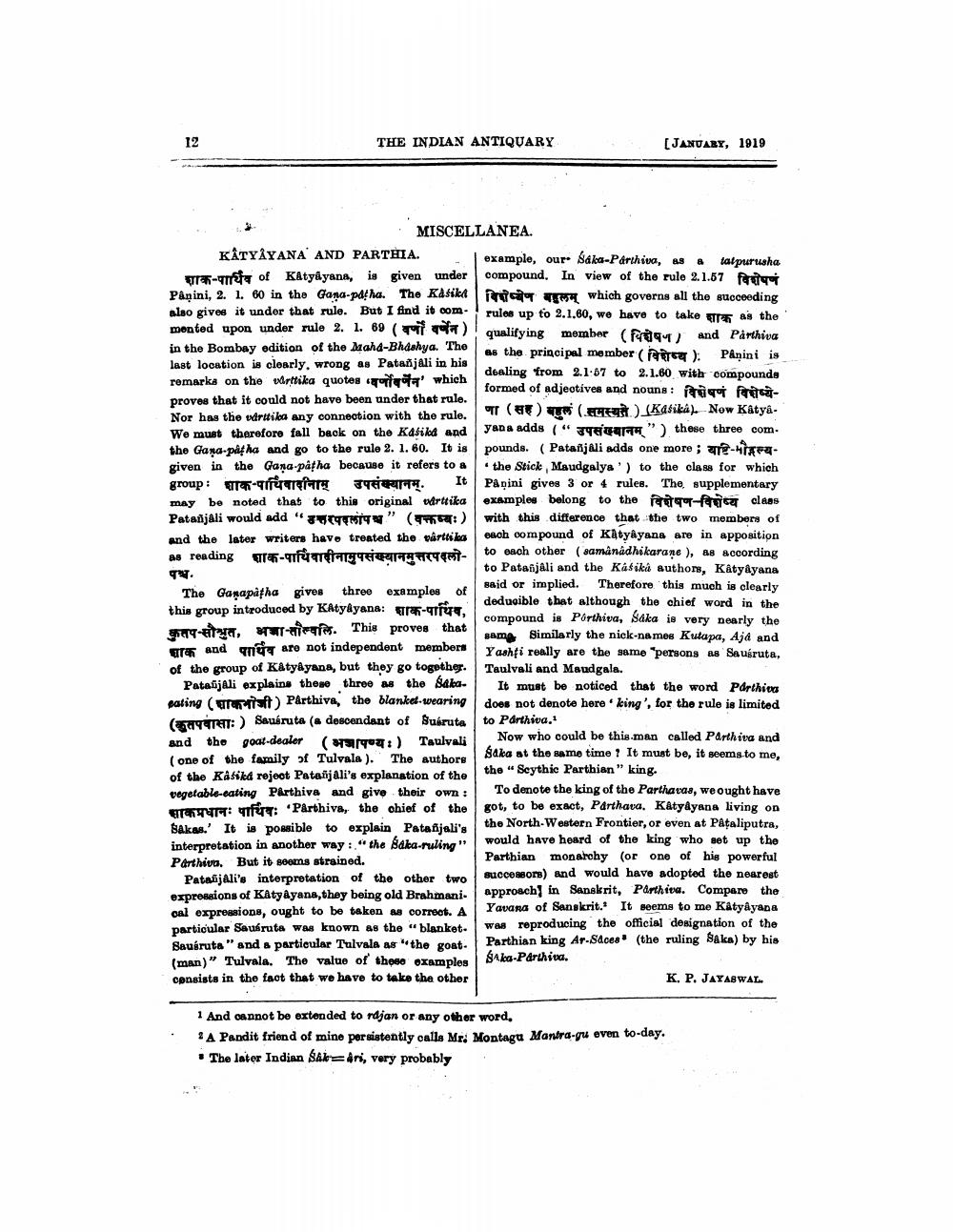________________
12
THE INDIAN ANTIQUARY
MISCELLANEA.
KATYAYANA AND PARTHIA.
- of Katyayana, is given under Panini, 2. 1. 60 in the Gana-patha. The Kasika also gives it under that rule. But I find it commented upon under rule 2. 1. 69 () in the Bombay edition of the Mahd-Bhashya. The last location is clearly, wrong as Patanjali in his remarks on the varttika quotes of which proves that it could not have been under that rule. Nor has the várttika any connection with the rule. We must therefore fall back on the Katika and the Gana-pâtha and go to the rule 2. 1. 60. It is given in the Gana-pâtha because it refers to a group: शाकपार्थिवादीनाम् उपसंक्यानम्.
example, our Sáka-Parthivo, as a talpurusha compound. In view of the rule 2.1.57 fair विशेष्येण बहुलम् which governs all the succeeding rules up to 2.1.60, we have to take as the qualifying member (f) and Parthiva as the principal member (s): Panini is dealing from 2.1:87 to 2.1.60 with compounds formed of adjectives and nouns: fitणा (सह ) बहुलं ( समस्यते ) (Kasika). Now Katy&yana adds ("") these three com. pounds. (Patanjali adds one more; -- the Stick, Maudgalya) to the class for which Panini gives 3 or 4 rules. The supplementary examples belong to the -c class with this difference that the two members of each compound of Katyayana are in apposition
It
may be noted that to this original varttika Patanjali would add "" (:) and the later writers have treated the vârttika
पश्च.
as reading -fâardiangqeicaragua- to each other (samânadhikarane), as according to Patanjali and the Kášiká authors, Katyayana said or implied. Therefore this much is clearly deducible that although the chief word in the compound is Porthiva, Saka is very nearly the sama Similarly the nick-names Kutapa, Ajá and Yashfi really are the same "persons as Sausruta, Taulvali and Maudgala.
The Ganapatha gives three examples of this group introduced by Katyayana: -, कुतप-स् -सौश्रुत, भज्जा-सौवलि. This proves that शाक and पार्थिव are not independent members of the group of Katyayana, but they go together. Patanjali explains these three as the Sakaeating (est) Parthiva, the blanket-wearing (:) Sauéruta (a descendant of Susruta and the goat-dealer (:) Taulvali (one of the family of Tulvala). The authors
of the Käsiká reject Patanjali's explanation of the vegetable-eating Parthiva and give their own:
cr: fire: Parthiva, the chief of the Bakas.' It is possible to explain Patanjali's interpretation in another way:" the Baka-ruling" Parthiva. But it seems strained.
[JANUARY, 1919
Patanjali's interpretation of the other two expressions of Katyayana, they being old Brahmanical expressions, ought to be taken as correct. A particular Sauéruta was known as the "blanketSausruta" and a particular Tulvala as "the goat. (man)" Tulvala. The value of these examples consists in the fact that we have to take the other
It must be noticed that the word Parthiva does not denote here king', for the rule is limited to Parthiva.1
Now who could be this man called Parthiva and
Saka at the same time? It must be, it seems to me, the "Scythic Parthian" king.
To denote the king of the Parthavas, we ought have got, to be exact, Parthava. Katyayana living on the North-Western Frontier, or even at Pâțaliputra, would have heard of the king who set up the Parthian monarchy (or one of his powerful successors) and would have adopted the nearest approach] in Sanskrit, Parthiva. Compare the Yavana of Sanskrit. It seems to me Kâtyâyana was reproducing the official designation of the Parthian king Ar-Saces (the ruling Saka) by his Ska-Parthiva.
1 And cannot be extended to rdjan or any other word.
2 A Pandit friend of mine persistently calls Mr. Montagu Mantra-gu even to-day. The later Indian Sakari, very probably
K. P. JAYASWAL.




